This post contains affiliate links.
Planning a summer trip to Europe? Check out this funky gypsy wagon that’s located on a beautiful property in southern France. This cabin is just right for two people staying on a holiday here.
With a small front porch you can enjoy the view of the surrounding property.
Inside the wagon you can see how cozy the bedroom is plus there are a few sitting chairs for reading.
The bathroom is located at the back of the cabin. Outside is a nice gazebo for outdoor cooking.
What do you think of this gypsy wagon? Would you stay in this bed and breakfast?
Gypsy Wagon Bed and Breakfast in France

Images © Airbnb
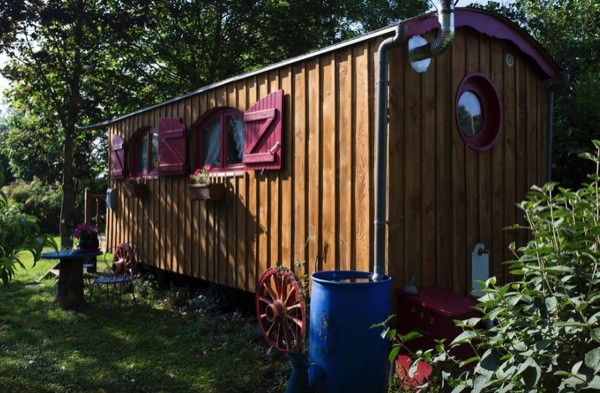
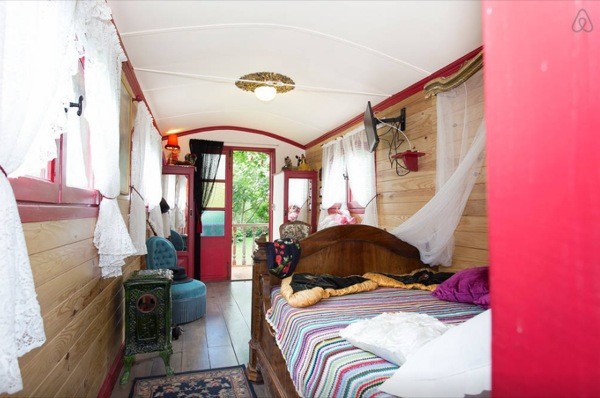
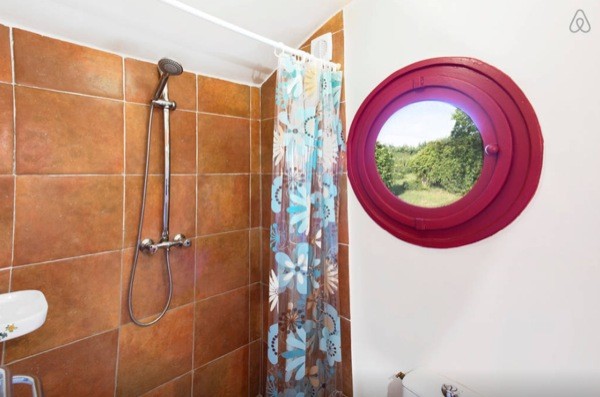
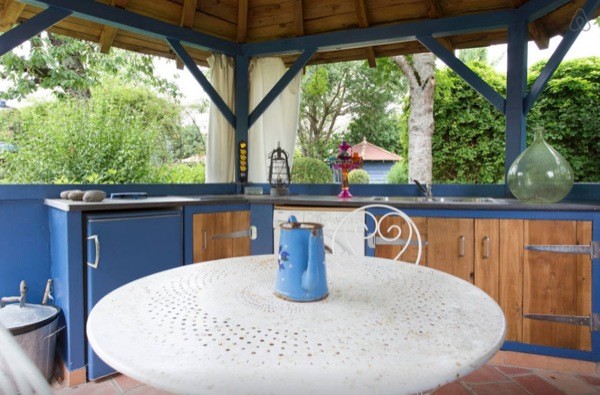
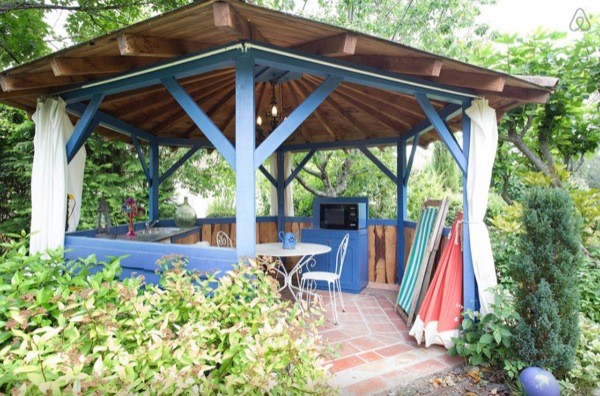

Images © Airbnb
Learn more: https://www.airbnb.com/rooms/3282379
You can share this Rustic and Luxurious Tiny Cottage with your friends and family for free using the e-mail and social media re-share buttons below. Thanks.
If you enjoyed this Rustic and Luxurious Tiny Cottage you’ll absolutely LOVE our Free Daily Tiny House Newsletter with even more! Thank you!
This post contains affiliate links.
Latest posts by Andrea (see all)
- The Overlook Box Hop Shipping Container Home - March 29, 2024
- The Fat Pony Social Club: From Rusty Horse Lorry to Bar on Wheels - February 4, 2024
- The Fat Pony Hideaway: an Off-Grid Cabin on Wheels - February 4, 2024




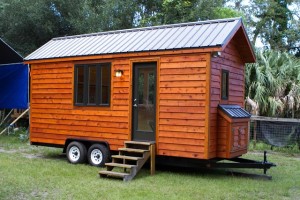

Very cute and charming; definitely a unique way to stay and visit in France.
I must make mention, however, of all these tiny homes that feature OUTDOOR kitchen spaces….does it NEVER rain or have minging weather in these zones? ANYONE who’s ever-ever done camping and relied on sublime weather only to discover unseasonable temps or days of rain can soon tell you that you can NEVER rely on the weather! Regardless of what part of the globe we’ve traveled to for holiday, there’s been times that we’ve been sorely disappointed in the “It NEVER rains here, normally!” statement that locals will share with us. Or snow or sleet or unseasonable cold/hot weather. I would hate to book a holiday in a place, banking on nice weather, only to have a miserable experience (as we certainly have had in the past). But that’s just me, perhaps other people don’t mind making dinner in the pouring rain or freezing temps. 😀
I’m sure that there’s rain (at least) sometimes where this gypsywagon is based, if not they wouldn’t have bothered with the gutter along the roof and the drum to collect the rain water.
It’s looking rather nice, and I wouldn’t mind at all to spend a couple of days there.
Peter.
Gypsy wagons don’t have rain gutters per se, and I’ve never heard of any Gypsy in the past collecting rain water in this manner. In their travels, they would camp by streams or ponds rather than attempt to carry large amounts of water: (water weighs 8.3454 pounds per gallon). The lack of gutters was especially true of “Bowtop” vardos (aka Open Lots) which are rounded, canvas topped wagons; a less expensive model of travel wagon and thus the more popular model, instead of the 6′ x 12′ box Reading (pronounced Redding) which is kite shaped with walls inside the wheels and slanting up and outwards to the roof, or Ledge wagons which have walls out over the wheels that are perpendicular to the roof and extended platform, which are a highly decorated, labor intensive (and therefore are a much more expensive) build. For examples of Open Lot wagons, go here:
http://www.bing.com/search?q=picture+of+an+Open+Lot+vardo&qs=n&form=QBLH&pq=picture+of+an+open+lot+vardo&sc=0-22&sp=-1&sk=&cvid=c8fa9c274ab042b99f194edabb62b417
PS Gypsies did not build their own wagons originally; it was British carpenters who did the actual work for Romanichal Gypsies, but the carpenters built to the specifications, requests and suggestions of the Gypsies. However, today the art of fine vardo building is often accomplished by modern Gypsies who have taken over these skills since many now are living in fixed locations behind bricks and can have the full carpentry workshops necessary for this sort of build.
Cute place and I want to try the French cuisine so let it rain;)
Just because a box on wheels has a half-barrel roof with an overhang does not make it a “gypsy wagon”. I really don’t see this as any kind of gypsy wagon, but rather a circus wagon. I’ve only ever seen such a long box with such small wheels so low to the ground on circus vans.
Gypsy wagons may have smaller wheels in the front but not on both the front and back. Usually a gypsy living wagon sits up high and never so close to the ground. In gypsy life, when a couple have enough children, the children sleep inside the wagon and the parents sleep under the wagon. This wagon sits too low for that.
Also, the average size of a true gypsy wagon is 6′ x 12′. This build is much longer than that. Go here and see the gallery for the different types of REAL gypsy wagons aka a “living wagon” aka a “vardo”; “vardo” means “living wagon”.) http://gypsyvans.com/gallery.html
My thoughts exactly. Thanks for the link, there were lots of pictures and good information!
And as an after thought:
Gypsy wagons also have a “pan box” on the back end of the wagon that this build does not. A pan box is unique to Gypsy vardos. Gypsies cook out-of-doors, usually in a small stone lined pit with a tripod from which hangs their kettles, pots and pans. Thus, these utensils were not stored inside the wagon, but rather in the pan box located at the back of the wagon and underneath the “cratch” (a crib for animal fodder that is usually made from knotted rope and hung at the back of the wagon for storage.) This build has neither the pan box nor a cratch on it, so more proof that this is not a Gypsy living wagon.
Cooking outdoors not appealing to me ever unless for grilling or to avoid strong odors such as fish…:(
While I wholeheartedly agree this is not a gypsy wagon, I also think that as a vardo-inspired bed and breakfast, it’s pretty sweet. I think a ten to twelve foot long true vardo wouldn’t get nearly as many of the citybred folk coming to stay. I know the ‘tipi camp’ was much more popular with 21′ canvas wannabes thank the 14′ traditional hide tipis. Reality is such a letdown to some people. I would go with the real thing over this, but this is still pretty cool, and totally trumps having to stay in some strangers house.
Regarding the tart criticisms of wether it’s really a gypsy wagon and why it’s not. First and for most it’s a bed and breakfast in France..it’s number one priority is to cater with its themed amenities to its prospective guest. Maybe I am missing the point and the goal of some is to show the French that they do not have an automatic gold metal when it comes to being smug while piling it on but personally if I was contemplating spending my hard earned money on a unique stay with my wife neither of us would give a rip if it’s to long and our quarters should be more cramped or that it does not have a pot and pan box with a latched lid no less. Sounds like some need to get out of there cramped living quarters get some fresh air and lighten up.